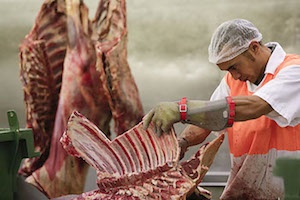China's Poultry and Beef Market State in 2024

Poultry: Cautious Growth
In 2024 , China’s poultry production grew slightly, thanks to concerted efforts to manage excess supply. In previous years, large capacity expansions had created a glut, creating the need for regulation. However, demand for poultry remains weak, making it difficult to rebalance the market. Lower prices for feeds
such as corn and soybean meal have helped improve profitability, but they are still below the level needed for sustainable development. Poultry imports also increased significantly, driven by renewed supplies from the United States . At the same time, local producers reduced their supplies, leading to a 30% year-on-year decline in total poultry imports. The main suppliers were Brazil , RUSSIA , Thailand and the United States.
Beef: Falling Prices and Declining Stocks
The situation on China’s beef market is also worrying. Beef demand remains weak, with retail prices falling sharply by 17% to US$9.21 per kilogram in October 2024. Despite the subsequent stabilisation of prices, producers have been forced to reduce livestock numbers to minimise losses. This reduction in livestock numbers could have long-term implications for the sector, as rebuilding livestock numbers takes time and resources.
Beef imports, on the other hand, showed a slight increase of 3% in the first three quarters of 2024. This is due to a fall in global beef prices compared to the previous year, making imports more attractive to Chinese consumers. However, frozen beef stocks decreased in the second half of the year, which could lead to a shortage in the market in the future.
Outlook for 2025
Based on current trends, experts expect that both poultry and beef imports could continue to rise in 2025 if domestic demand does not recover. However, this will depend on a variety of factors, including global price fluctuations, changing consumer preferences, and government agricultural policies.
The Chinese MEAT market, both poultry and beef, continues to be in a state of uncertainty. Producers and analysts must closely monitor changes in supply and demand, as well as external factors that may impact prices and availability. It is important for the industry to adapt to the new conditions and find ways to improve sustainability and profitability in the long term.
Read together with it:
- Belstat reported how much grain, milk, meat, and vegetables are produced in Belarus per capita.November 14, MINSK . Belarus produces 913 kg of grain, 958 kg of MILK, 341 kg of potatoes, and 304 kg of vegetables per capita, according to a review by the National Statistical Committee for the Day of Agricultural and Processing Industry Workers, BELTA reports. The country also produces 78 kg of fruits and berries, 147 kg of livestock and poultry (slaughter weight), and 4......
- The IEA sees a risk of a decline in oil production in Russia due to sanctions.The IEA sees a risk of reduced oil production in RUSSIA due to US sanctions , but maintains its production forecast. According to the IEA, Russian oil exports will remain unchanged.There is a "significant downside risk" to Russia's oil production forecast due to US sanctions, the International Energy Agency (IEA) said in a report.BLOOMBERG . The agency's experts believe that the latest US sanction...
- UniCredit заявил о галактических усилиях из-за санкций против РоссииUniCredit старается не нарушить «более 15 тыс. санкций», а также не «совершать ошибки», которые позволят изъять его активы в России, заявил гендиректор. После начала военной операции банк начал рассматривать возможность ухода Итальянский банк UniCredit прилагает «галактические усилия», пытаясь соблюсти международные санкции в отношении своего российского подразделения. Об этом заявил генеральный д...
- Russian agriculture: self-sufficiency continues to growThe industry has a track record of implementing new technologies and increasing productivity. RUSSIA is already confidently self-sufficient in grain, MEAT, fish, vegetable oil, and SUGAR. Grain and vegetable production is also forecast to be higher this year, despite unfavorable weather conditions in some regions. The Ministry expects historic highs for some crops and continues to support agricult...
- Низкое предложение и устойчивый спрос: в Аргентине растут цены на мясоЦены на говядину снова выросли, что отразилось на полках супермаркетов и в мясных магазинах. За последние две недели розничные цены выросли на 8–12%, а на некоторые популярные отрубы рост превысил 15% по сравнению с октябрем. Тем не менее, продажи остаются высокими: потребители продолжают покупать, принимая новые цены и закрепляя тенденцию, которая повторяется каждый год в конце года, когда спрос ...


